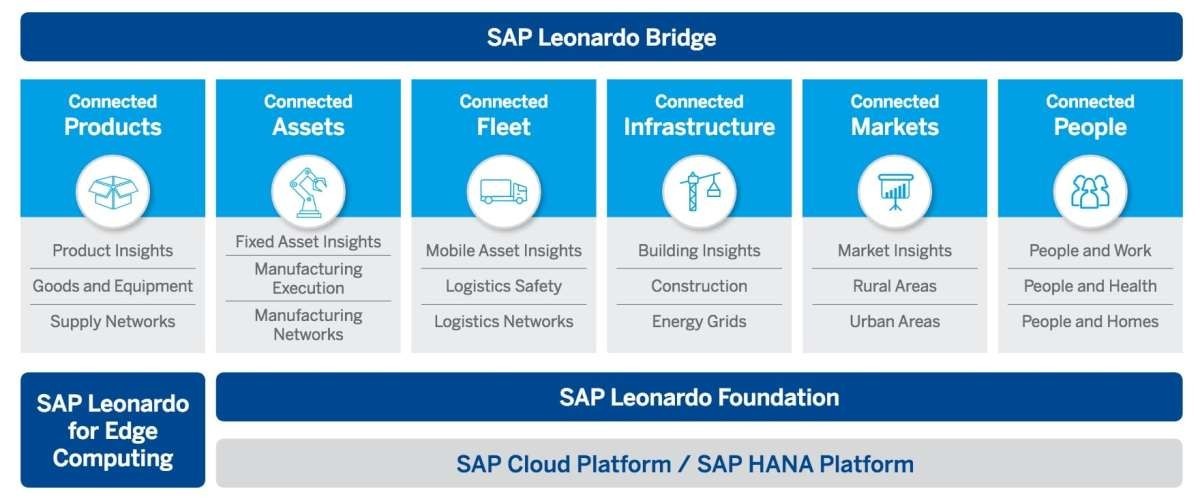your journey
Let’s talk ‘Things’ – Introducing SAP Leonardo
What is the Internet of Things (IoT)?
Internet of Things definition: The vast network of devices connected to the Internet, including smart phones and tablets and almost anything with a sensor on it – cars, machines in production plants, jet engines, oil drills, wearable devices, and more. These “things” collect and exchange data.
IoT – and the machine-to-machine (M2M) technology behind it – are bringing a kind of “super visibility” to nearly every industry. Imagine utilities and telcos that can predict and prevent service outages, airlines that can remotely monitor and optimise plane performance, and healthcare organisations that can base treatment on real-time genome analysis. The business possibilities are endless.
The Industrial Internet of Things (IIoT)
The IIoT, or the Industrial Internet, is driving unprecedented insights and efficiencies in the manufacturing industry. Machine learning, M2M communication, sensor data, and automation technologies work together to create autonomous smart machines and connected factories.
What is the Internet of Everything (IoE)?
The Internet of Everything adds intelligent connections between things and devices, people, processes, and data. IoE systems make sensor data more meaningful and have a secure, usable infrastructure that lets actionable information be shared across the business ecosystem.
Introducing SAP Leonardo
Leonardo da Vinci had a vision for how we should leverage “things” before the rest of us – from self-propelled carts to robotic knights. That’s why SAP named their new IoT applications portfolio after him. The portfolio contains several toolkits. The skill is determining the right tools for your solution.

SAP Leonardo Bridge
Combines real-time information from connected things with business processes to turn extended supply chains into live supply chain environments
Range of packaged enterprise end-to-end solutions for connected things from products to people across line-of-business and industry use cases.
SAP Leonardo foundation
Includes both best of breed business services that enable users to rapidly build IoT applications by building digital twins, reusable application services, and applying predictive algorithms; and core technical services to process a high velocity of data with the ability to stream analytics and run predictive scenarios. These are delivered on new generation SAP Cloud Platform coming from millions of devices.
SAP Leonardo for Edge computing
Ingests data irrespective of connectivity, latency, device protocols concerns, and (at the same time) delivers intelligent edge applications.
Explore SAP Leonardo IoT applications
Connected Products – Smart, connected products and the data they collect are transforming how companies work. To build these B2B and B2C products – such as smart home automation products, wearables, goods and equipment, and other IoT devices – they’re adopting entirely new technology stacks.
Connected Assets – The Industrial Internet of Things (IIoT) offers limitless possibilities for smart, digital manufacturing and asset management. Automation controls and sensor data can improve predictive maintenance, asset uptime, manufacturing execution systems, supply chains, and more.
Connected Fleet – In the era of the connected fleet – sensor-equipped vehicles, robots, and forklifts – new opportunities abound. IoT devices and live sensor data can be used to improve safety and services, optimise GPS fleet tracking, and achieve smart fleet and logistics management.
Connected Infrastructure – IoT devices and sensors are revolutionising work site, property, and real estate management. Companies can set up smart building automation systems for lighting, air conditioning, and more – and use new construction technology to create highly productive work sites.
Connected Markets – By 2050, 75% of the world’s population will live in cities, and smart city technology – such as intelligent transportation systems and smart grids – will help infrastructure keep up. Citizens also expect marketplaces to become hyper personalised and all-knowing.
Connected People – IoT wearable technology, devices, and gadgets have many uses in the healthcare and fitness industries – as well as the workplace. For example, smart glasses and wearable technology clothing make it easy for employees to work hands-free in the office or in the field.
Share this:

Neil ran his first SAP transformation programme in his early twenties. He spent the next 21 years working both client side and for various consultancies running numerous SAP programmes. After successfully completing over 15 full lifecycles he took a senior leadership/board position and his work moved onto creating the same success for others.